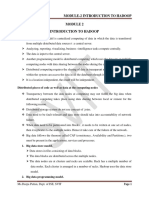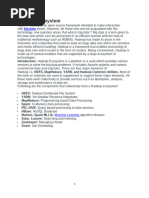BDA Module 2 Chapter 1
BDA Module 2 Chapter 1
Uploaded by
Prathibha RangaswamyCopyright:
Available Formats
BDA Module 2 Chapter 1
BDA Module 2 Chapter 1
Uploaded by
Prathibha RangaswamyCopyright
Available Formats
Share this document
Did you find this document useful?
Is this content inappropriate?
Copyright:
Available Formats
BDA Module 2 Chapter 1
BDA Module 2 Chapter 1
Uploaded by
Prathibha RangaswamyCopyright:
Available Formats
Jain College of Engineering and Research, Belagavi BIG DATA ANALYTICS (18CS72)
MODULE 02
CHAPTER 1
Introduction to Hadoop
Hadoop is a open source software framework.
Scalable and parallel computing platform to handle large amount of data.
Distributed data storage system do not use the concept of JOINS.
Data need to be fault tolerant.
Big data should follow the CAP theorem.
Big Data Store model
Data store in file system consist of Data Blocks(Physical division of large data).
Data blocks are distributed across multiple nodes(Data nodes).
Data nodes are stored at the racks of a clusters.
Each rack has multiple data nodes(Data servers).
Hadoop system uses the Data Store Model
Data blocks are replicate at the data nodes if any one get failed.
Big data programming model
Hadoop system will uses the Big Data Programming model.
Big Data programming model is that application in which application jobs and tasks is
scheduled on the same servers which stores the data for processing.
Job means running an assignment of a set of instructions for processing. Example,
Processing the queries in application and sending back to the application is job.
Job scheduling means assigning a job for processing.
Key Terms
Cluster Computing
Refers to the computing, storing and analyzing huge amounts of unstructured or structured
data in a distributed computing environment.
Each cluster forms loosely or tightly connected computing nodes that work together.
Prof. Laxmi Deshpande, Dept. of CSE Page
Jain College of Engineering and Research, Belagavi BIG DATA ANALYTICS (18CS72)
Improves the performance cost effectiveness and accessibility
Data Flow
Flow of data from one node to another node.
.Data consistency
All copies of the data blocks should have same value
Data availability
At least one copy of the data should be available if partition becomes inactive.
Resources
Availability of physical/virtual components or devices.
Resource Management
Managing resources such as creation, deletion or the manipulation of resource data.
Horizontal Scalability
Increasing number of systems working in coherence.
Example: MPPs
Vertical Scalability
Increasing the number of tasks in the system. Tasks like reporting, Business processing(BP),
Business Intelligent(BI) Tasks.
Ecosystem
Made up of multiple computing components which work together.
Hadoop and its Ecosystem
Hadoop Ecosystem is a platform or a suite which provides various services to solve the big
data problems.
It includes Apache projects and various commercial tools and solutions.
Most of the tools or solutions are used to supplement or support the core elements of
Hadoop. All these tools work collectively to provide services such as absorption, analysis,
storage and maintenance of data etc.
Prof. Laxmi Deshpande, Dept. of CSE Page
Jain College of Engineering and Research, Belagavi BIG DATA ANALYTICS (18CS72)
Hadoop Core Components
Above diagram shows the Core components of Hadoop.
1. Hadoop Common
The common module contains the libraries and utilities that are required by the other
modules of hadoop.
Hadoop common provides various components and interfaces for distributed file system
and general input/output. This includes serialization and file based data structures.
2. Hadoop Distributed File System(HDFS)
A java based distributed file system which can store all kinds of data on the disks at the
clusters.
3. Map Reduce v1
Software programming model in Hadoop 1 using Maper and Reducer. The v1processes
large data sets in parallel and in batches.
4. YARN
Software for managing resources for computing.
The user application tasks or sub-tasks run in parallel at the hadoop, uses scheduling
and handles the requests for the resources in distributed running of the tasks.
Prof. Laxmi Deshpande, Dept. of CSE Page
Jain College of Engineering and Research, Belagavi BIG DATA ANALYTICS (18CS72)
5. Map Reduce v2
Hadoop 2 YARN-based system for parallel processing of the application tasks.
Spark
Open source frame work
Cluster computing frame work
Provides in-memory analytics
Enables OLAP and Real time processing
Adapted by the companies like Amazon, eBay, and Yahoo.
Features of Hadoop
Fault-efficient scalable, flexible and modular design
Hadoop uses simple and modular programming model.
The system provides server at high scalability.The system is scalable by adding new
nodes to handle large data.
Hadoop proves very helpful in storing , managing, processing and analyzing Big data.
Modular functions make system flexible.
One can add or replace components at ease.
Robust design of HDFS
Execution of big data applications continue even when an individual server or cluster
fails. This is because of hadoop provisions of backup and recovery mechanism.
HDFS has high reliability.
Store and process Big Data
Processes Big data of 4V characteristics(Volume, Variety, volume, Veracity)
Distributed Clusters computing model with data locality
Processes Big data at high speed as the application tasks and sub tasks submit to the
DataNodes.
One can achieve more computing power by increasing the number of computing nodes.
Prof. Laxmi Deshpande, Dept. of CSE Page
Jain College of Engineering and Research, Belagavi BIG DATA ANALYTICS (18CS72)
The processing splits across multiple DataNodes, and thus fast processing and
aggregated results.
Hardware fault-tolerant
A fault does not affect data and application processing.
If a node goes down, the other nodes take care of the residue.
This is due to multiple copies of all data blocks which replicate automatically.
Open source framework
Open source access and cloud services enable large data store.
Hadoop uses a cluster of multiple inexpensive servers or the cloud.
Java and Linux Based
Hadoop uses Java interfaces.
Hadoop base is Linux but has its own set of shell command support.
Hadoop provides various components and interfaces for distributed file system and general
input/output.
HDFS is basically designed more for batch processing.
YARN provides a platform for many different modes of data processing, from traditional
batch processing to processing of the applications such as interactive queries, text analytics
and streaming analytics.
Hadoop Ecosystem Components
Hadoop ecosystem refers to a combination of technologies.
Hadoop ecosystem consist of own family of applications which tie up together with the
hadoop.
The system component support the storage, processing, access, analysis, governance,
security and operations for Big data.
The system enables the applications which run Big Data and deploy HDFS.
The data store system consist of clusters, racks, DataNodes and blocks.
Hadoop deploys application programming model, such as MapReduce and HBase. YARN
manages resources and schedules sub-tasks of the application.
Prof. Laxmi Deshpande, Dept. of CSE Page
Jain College of Engineering and Research, Belagavi BIG DATA ANALYTICS (18CS72)
Below figure shows the Hadoop Core components HDFS, MapReduce and YARN along
with the ecosystem. Ecosystem includes the application support layer and application layer
components.
Components are AVRO, Zookeeper, Pig, Hive, Sqoop, Ambari, Mahout, Spark, Flink and
Flame.
Four layers in above diagram are as follows
1. Distributed Storage Layer
2. Resource-manager layer for job or application sub-tasks scheduling and execution.
3. Processing-frame work layer, consisting of Maper and Reducer for the MapReduce
process flow.
4. APIs at application support layer. The codes communicate to APIs
Prof. Laxmi Deshpande, Dept. of CSE Page
Jain College of Engineering and Research, Belagavi BIG DATA ANALYTICS (18CS72)
AVRO enables data serialization between the layers.
Zookeeper enables coordination among layer components and it is a centralized server
which provides the configuration of layers.
Mahout is the ready to use framework.
Hadoop Streaming
HDFS with MapReduce and YARN-based system enables parallel processing of large
datasets.
Spark provides in-memory processing of data thus improves processing speed.
In hadoop streaming spark and Flink are used to interface between the Maper and Reducer.
Flink improves overall performance as it provides single run-time for streaming as well as
batch processing.
Hadoop Pipes
This is another way to interface or connecting between the Maper and Reducer .
C++ pipes are used for interfacing.
Hadoop Distributed File System(HDFS)
Big data analytics applications are software applications.
HDFS is a core component of Hadoop.
HDFS is designed to run on a cluster of computers and servers at cloud based utility
services.
HDFS stores Big Data range from GBs to PBs.
HDFS Data Storage
Hadoop data store concept implies storing the data at a number of clusters.
Each cluster has a number of data stores, called racks. Each rack stores a number of
DataNodes.
Each DataNode has a large number of Data Blocks.
A rack distribute across a cluster. The nodes have storing and processing capabilities.
The data blocks replicate by default at least on three data nodes in same or remote nodes.
Prof. Laxmi Deshpande, Dept. of CSE Page
Jain College of Engineering and Research, Belagavi BIG DATA ANALYTICS (18CS72)
Below diagram shows the replication of data blocks.
Features of HDFS
Create, append, delete, rename and attribute modification functions.
Content of individual file cannot be modified or replaced but appended with new data at the
end of the file.
Write once but read many times during usages and processing.
Average file size can be more than 500MB
Hadoop Physical Organization
The conventional file system uses directories.
A directory consists of folders. A folder consists of files.
When data processes, the data sources identify by pointers for the resources.
A data-dictionary stores the resources pointers. Master tables at the dictionary store at a
central location. The centrally stored tables enable administration easier when the data
sources change during processing.
The files,DataNodes and blocks need the identification during processing at HDFS. HDFS
use the NameNode and DataNode.
Prof. Laxmi Deshpande, Dept. of CSE Page
Jain College of Engineering and Research, Belagavi BIG DATA ANALYTICS (18CS72)
Few nodes in Hadoop cluster act as NameNodes. These nodes are termed as Master Nodes
or simply Masters.
These masters have the different configurations and processing power.
Master nodes have less local storage.
Majority of the nodes in hadoop cluster acts as DataNodes and TaskTrackers. These nodes
are refered to as slave nodes or slaves.
The slaves have lots of disk storage and moderate amounts of processing capabilities.
Slaves are responsible to store the data and process the computation tasks submitted by the
clients.
Below diagram illustrates the above explanation
A single master node provides HDFS, MapReduce and Hbase using threads in small to
medium sized clusters.
When the cluster size is large, multiple servers are used, such as to balance the load.
The secondary NameNode provides Name node management services and Zookeepr is used
by HBase for metadata storage.
The master node fundamentally plays the role of a coordinator.
Prof. Laxmi Deshpande, Dept. of CSE Page
Jain College of Engineering and Research, Belagavi BIG DATA ANALYTICS (18CS72)
The master node receives client connections, maintains the description of the global file
system name space, and the allocation of file blocks.
It also monitors the state of the system in order to detect any failure.
MasterNode consists of 3 components NameNode, Secondary Node and Job tracker.
The NameNode stores all the file system related information such as:
The file section is stored
Last access time for the file
User permissions like which user has access to the file.
Secondary NameNode is an alternate for NameNode. Secondary node keeps a copy of
NameNode meta data.
Masters and slaves, and hadoop client(node) load the data into clusters, submit the
processing job and then retrieve the data to see the response after the job completion.
Hadoop 2
Single NameNode failure in Hadoop 1 is an operational limitation. Scaling up was also
restricted to scale beyond a few thousands of DataNodes and few number of clusters.
Hadoop 2 provides the multiple NameNodes.This enables higher resources availability.
Each Master Node has the following components.
An associated NameNode
Zookeeper coordination client(an associated NameNode), functions as a centralized
repository for distributed applications. Zookeeper uses synchronization, serialization,
and coordination activities.
Associated JournalNode(JN) . The JN keeps the records of the state, resources assigned,
and intermediate results. The System takes care of failure issues as follows.
Prof. Laxmi Deshpande, Dept. of CSE Page
Jain College of Engineering and Research, Belagavi BIG DATA ANALYTICS (18CS72)
HDFS Commands
HDFS commands are common to other modules of Hadoop. The HDFS shell is not
complaint with the POSIX.
Thus, the shell cannot interact similar to Unix or Linux.
Commands for interacting with the files in HDFS require /bin/hdfs dfs <args>, where args
stands for the command arguments.
Below table shows the examples and usages of commands.
Prof. Laxmi Deshpande, Dept. of CSE Page
Jain College of Engineering and Research, Belagavi BIG DATA ANALYTICS (18CS72)
Prof. Laxmi Deshpande, Dept. of CSE Page
You might also like
- BDA Module 2Document40 pagesBDA Module 2abhijnas005No ratings yet
- 2-NotesDocument61 pages2-Notesswathidarla.rvitmNo ratings yet
- BDA Mod2@AzDOCUMENTS - inDocument64 pagesBDA Mod2@AzDOCUMENTS - inramyaNo ratings yet
- Module 2 CNDocument23 pagesModule 2 CNmksaravanamk1No ratings yet
- Hadoop EcosystemDocument7 pagesHadoop EcosystemKhushi PandeyNo ratings yet
- Module-2 - Introduction To HadoopDocument13 pagesModule-2 - Introduction To HadoopshreyaNo ratings yet
- Unit 3 BdaDocument13 pagesUnit 3 BdamokshagnapatelNo ratings yet
- CC-KML051-Unit VDocument17 pagesCC-KML051-Unit VFdjsNo ratings yet
- BDA Notes Unit-2Document27 pagesBDA Notes Unit-2Varshini DirishalaNo ratings yet
- Haddob Lab ReportDocument12 pagesHaddob Lab ReportMagneto Eric Apollyon ThornNo ratings yet
- Big Data Module 2Document23 pagesBig Data Module 2Srikanth MNo ratings yet
- An Overview of The Hadoop EcosystemDocument9 pagesAn Overview of The Hadoop EcosystemOm BhaydeNo ratings yet
- Big Data Unit 4Document96 pagesBig Data Unit 4HARIOM VERMANo ratings yet
- Unit 2Document23 pagesUnit 2mukul.money2003No ratings yet
- Syllabus:: Introduction To Hadoop (T1)Document23 pagesSyllabus:: Introduction To Hadoop (T1)sanishwin2002No ratings yet
- Unit 2 Big Data NotesDocument21 pagesUnit 2 Big Data Notespahadesunanda17No ratings yet
- Module 2 BDADocument64 pagesModule 2 BDAsomeshgowda7975No ratings yet
- Unit 2Document56 pagesUnit 2Ramstage TestingNo ratings yet
- BDA Unit 3Document6 pagesBDA Unit 3SpNo ratings yet
- Module - 2 HalfDocument12 pagesModule - 2 Halfs8143152No ratings yet
- Chapter - 2 HadoopDocument32 pagesChapter - 2 HadoopRahul PawarNo ratings yet
- Hadoop Ecosystem PDFDocument6 pagesHadoop Ecosystem PDFKittuNo ratings yet
- Chapter 2Document19 pagesChapter 2lalisagutamaNo ratings yet
- HADOOPDocument19 pagesHADOOPucebittrichy2020No ratings yet
- Big Data - Unit 2 Hadoop FrameworkDocument19 pagesBig Data - Unit 2 Hadoop FrameworkAditya Deshpande100% (1)
- Unit IiiDocument20 pagesUnit Iiisrinivas79668No ratings yet
- Experiment No - 01Document14 pagesExperiment No - 01AYAAN SatkutNo ratings yet
- Module-2Document23 pagesModule-2rashmita kNo ratings yet
- Act2 - March7 - 6E - BDA - SECDocument8 pagesAct2 - March7 - 6E - BDA - SECyadukrishnagiriworkNo ratings yet
- Big Data Technologies On Map Reduce and HadoopDocument2 pagesBig Data Technologies On Map Reduce and HadooppriyaNo ratings yet
- Big Data Lab ManualDocument44 pagesBig Data Lab Manualamartya1820No ratings yet
- BDA Unit 2 Q&ADocument14 pagesBDA Unit 2 Q&AviswakranthipalagiriNo ratings yet
- Big Data and Hadoop GuideDocument8 pagesBig Data and Hadoop GuideRoxana Godoy AstudilloNo ratings yet
- shawnDocument4 pagesshawnianzeha21No ratings yet
- .Analysis and Processing of Massive Data Based On Hadoop Platform A Perusal of Big Data Classification and Hadoop TechnologyDocument3 pages.Analysis and Processing of Massive Data Based On Hadoop Platform A Perusal of Big Data Classification and Hadoop TechnologyPrecious PearlNo ratings yet
- Hadoop EcosystemDocument49 pagesHadoop Ecosystem21ve1a6772No ratings yet
- Bda 18CS72 Mod-2Document152 pagesBda 18CS72 Mod-2Dhathri ReddyNo ratings yet
- IMTC634_Data Science_Chapter 13Document16 pagesIMTC634_Data Science_Chapter 13msmakkar.chief19No ratings yet
- Bda Unit 2Document44 pagesBda Unit 2K .V. Sai KaranNo ratings yet
- Hadoop Ecosystem: Hdfs Mapreduce Yarn Hadoop CommonDocument5 pagesHadoop Ecosystem: Hdfs Mapreduce Yarn Hadoop CommonHarshdeep850No ratings yet
- Big Data Analytics Unit-3Document15 pagesBig Data Analytics Unit-34241 DAYANA SRI VARSHANo ratings yet
- Bda - 10Document7 pagesBda - 10deshpande.pxreshNo ratings yet
- 2 HadoopDocument20 pages2 HadoopYASH PRAJAPATINo ratings yet
- What Is The Hadoop EcosystemDocument5 pagesWhat Is The Hadoop EcosystemZahra MeaNo ratings yet
- BDA Presentations Unit-4 - Hadoop, EcosystemDocument25 pagesBDA Presentations Unit-4 - Hadoop, EcosystemAshish Chauhan100% (1)
- HADOOP: A Solution To Big Data Problems Using Partitioning Mechanism Map-ReduceDocument6 pagesHADOOP: A Solution To Big Data Problems Using Partitioning Mechanism Map-ReduceEditor IJTSRDNo ratings yet
- M2Document28 pagesM2maddy07252628No ratings yet
- INTRO hadoop-ecosystemDocument6 pagesINTRO hadoop-ecosystemdanukrishnan003No ratings yet
- Big Data - HadoopDocument20 pagesBig Data - HadoopMutomba TichaonaNo ratings yet
- HadoopDocument11 pagesHadoopInu KagNo ratings yet
- Bda Lab ManualDocument40 pagesBda Lab Manualvishalatdwork5730% (1)
- Hadoop Features 2Document3 pagesHadoop Features 2sharan kommiNo ratings yet
- HADOOP ECOSSYTEM, COMPONENTS, Loading, Getting Data From HadoopDocument10 pagesHADOOP ECOSSYTEM, COMPONENTS, Loading, Getting Data From HadoopKunal TejwaniNo ratings yet
- Hadoop EcosystemDocument4 pagesHadoop Ecosystemshweta shedshaleNo ratings yet
- SDL Module-No SQL Module Assignment No. 2: Q1 What Is Hadoop and Need For It? Discuss It's ArchitectureDocument6 pagesSDL Module-No SQL Module Assignment No. 2: Q1 What Is Hadoop and Need For It? Discuss It's ArchitectureasdfasdfNo ratings yet
- Big Data Assignment 1Document6 pagesBig Data Assignment 1Ashutosh SahniNo ratings yet
- Big Data Frameworks: Architectures, Tools, and Techniques for Managing Large-Scale Data. Comprehensive review of Apache Hadoop, Spark and Flink.From EverandBig Data Frameworks: Architectures, Tools, and Techniques for Managing Large-Scale Data. Comprehensive review of Apache Hadoop, Spark and Flink.No ratings yet
- Eegame LogcatDocument4 pagesEegame Logcatrazaanth476No ratings yet
- Development and Control of Virtual Plants in A Co Simulation Environment 1Document35 pagesDevelopment and Control of Virtual Plants in A Co Simulation Environment 1Laura Maria RodriguezNo ratings yet
- Chapter 11: Indexing and HashingDocument47 pagesChapter 11: Indexing and HashingShivansh SaxenaNo ratings yet
- Jill - Lynn - 31 Aka AriesMoonRising36 Tits in Tops ForumDocument1 pageJill - Lynn - 31 Aka AriesMoonRising36 Tits in Tops ForumreidloupinNo ratings yet
- CHAPTER 2 Intro To Operating SystemDocument14 pagesCHAPTER 2 Intro To Operating SystemalexNo ratings yet
- FPT University: Lab 3 For Operating SystemsDocument2 pagesFPT University: Lab 3 For Operating SystemsPhan Nhat Tan (K16HCM)No ratings yet
- Hitachi Virtual Storage Platform 5000 Series Storage and HPE Synergy Configuration For SAN BootDocument41 pagesHitachi Virtual Storage Platform 5000 Series Storage and HPE Synergy Configuration For SAN BootTran Minh LongNo ratings yet
- Vsan 703 Monitoring Troubleshooting GuideDocument68 pagesVsan 703 Monitoring Troubleshooting Guideirobot.mmNo ratings yet
- BSC White Paper w97 Gentia SoftwareDocument20 pagesBSC White Paper w97 Gentia SoftwareChristiana SerpaNo ratings yet
- Sap Mm-Split Valuation: Road To SuccessDocument17 pagesSap Mm-Split Valuation: Road To SuccessYEDUKONDALU SIRIKONDA100% (2)
- 18ai63 - Java For Mobile Applications Question BankDocument15 pages18ai63 - Java For Mobile Applications Question BankSahithi BhashyamNo ratings yet
- Software Testing Question SolutionDocument14 pagesSoftware Testing Question Solutiontunes999officialNo ratings yet
- 7 Configuration ManagementDocument57 pages7 Configuration ManagementSamir Mezouar100% (1)
- Unit-3 - Hardware and SoftwareDocument9 pagesUnit-3 - Hardware and SoftwarehuzefaNo ratings yet
- Zoon Functionality - Personalization PDFDocument32 pagesZoon Functionality - Personalization PDFpravinprasad_d4831No ratings yet
- How Can You Achieve Safety and Profitability ?Document32 pagesHow Can You Achieve Safety and Profitability ?Mohamed OmarNo ratings yet
- ChatGPT Prompts For CybersecurityDocument70 pagesChatGPT Prompts For Cybersecurityravalurmit123100% (1)
- Amazon S3: An Storage ServiceDocument14 pagesAmazon S3: An Storage Servicesai suryaNo ratings yet
- TAFC or JBASE ConfigDocument21 pagesTAFC or JBASE ConfigGopinath KannasamudramNo ratings yet
- User Manual User Manual User Manual User Manual For Software For Software For Software For Software Token Token Token TokenDocument3 pagesUser Manual User Manual User Manual User Manual For Software For Software For Software For Software Token Token Token TokenFaruq77No ratings yet
- SAP Business Technology Platform Service Description Guide-Mar2021Document25 pagesSAP Business Technology Platform Service Description Guide-Mar2021Raymundo PiresNo ratings yet
- Artra Trading Portofolio Vr5Document23 pagesArtra Trading Portofolio Vr5Maged GarasNo ratings yet
- Ambyar 1 FIXDocument15 pagesAmbyar 1 FIXArdhan RachmanNo ratings yet
- Supportive Questions With Sloutions Pythons Meeting3 4 5 6Document41 pagesSupportive Questions With Sloutions Pythons Meeting3 4 5 6nawafzxsuNo ratings yet
- ME 402: How To Insert MATLAB Figures in MS-Word Documents: 110 Step Response of First-Order SystemDocument2 pagesME 402: How To Insert MATLAB Figures in MS-Word Documents: 110 Step Response of First-Order SystemKedir HassenNo ratings yet
- Aixcmds2 PDFDocument778 pagesAixcmds2 PDFJorge VarelaNo ratings yet
- The Queuemetrics Uniloader User ManualDocument47 pagesThe Queuemetrics Uniloader User ManualDenis RangelNo ratings yet
- Intro ToDocument2 pagesIntro Todmfrancisco2400No ratings yet
- MAN0155 - MATRIX-2 User GuideDocument30 pagesMAN0155 - MATRIX-2 User Guideducbao1309No ratings yet
- IGNOU Aknowledgement Slip - IGNOU Aknowledgement Receipt by SabOnlineHaiDocument2 pagesIGNOU Aknowledgement Slip - IGNOU Aknowledgement Receipt by SabOnlineHaiSabOnlineHai100% (1)

























































































